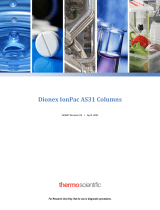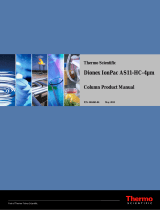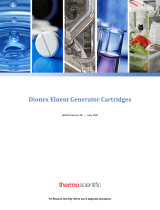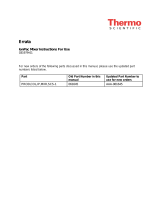Page is loading ...

PRODUCT MANUAL
IONPAC® FAST CATION I COLUMN
(4 x 250 mm, P/N SP5391)
QUICKSTART STEPS AND LINKS
Click blue text below to get started.
1. See Section 3, “Operation”. Note operation precautions and chemical purity
requirements. Make the required stock and working solutions for eluents.
3. See “Quality Assurance Report”. Run the Production Test Chromatogram as a system
check.
4. See Section 4, "Example Applications" for example applications.
5. See “Column Care" for column cleanup and long-term storage recommendations.
©DIONEX Corporation, 1997, 1998, 2002
Document No. 032952
Revision 06
7 November 2002

IonPac Fast Cation I Document No. 032952-06 Page 2 of 17
TABLE OF CONTENTS
SECTION 1 - INTRODUCTION ....................................................................................................... 4
SECTION 2 - INSTALLATION ......................................................................................................... 5
2.1 System Requirements ............................................................................................................................................... 5
SECTION 3 - OPERATION ............................................................................................................... 6
3.1 General Operating Conditions ................................................................................................................................. 6
3.2 Chemicals Required .................................................................................................................................................. 6
3.3 Solutions Required ................................................................................................................................................... 6
3.4 Sample Concentration ............................................................................................................................................... 6
SECTION 4 - EXAMPLE APPLICATIONS...................................................................................... 8
4.1 Analytes: Lithium, Sodium, Ammonium and Potassium .......................................................................................... 8
4.2 Analytes: Lithium, Sodium, Ammonium, Potassium, Rubidium and Cesium ......................................................... 9
4.3 Analytes: Magnesium, Calcium, Strontium and Barium ....................................................................................... 10
4.4 Analytes: Lithium, Sodium, Ammonium, Potassium, Magnesium and Calcium ....................................................11
4.5 Analytes: Lithium, Sodium, Ammonium, Potassium, Rubidium, Cesium Magnesium, Calcium,
Strontium and Barium ............................................................................................................................................ 12
SECTION 5 - TROUBLESHOOTING GUIDE............................................................................... 13
5.1 High Backpressure................................................................................................................................................. 13
5.2 High Background, Noise ........................................................................................................................................ 14
5.3 Poor Peak Resolution ............................................................................................................................................. 14
5.3.1 Loss of Column Efficiency ........................................................................................................................................ 14
5.3.2 Short Retention Times............................................................................................................................................... 15
5.4 Spurious Peaks ....................................................................................................................................................... 15
5.4.1 Sources of Column Contamination............................................................................................................................ 15
5.4.2 Baseline Upsets ........................................................................................................................................................ 15

IonPac Fast Cation I Document No. 032952-06 Page 3 of 17
SECTION 6 - COLUMN CARE ...................................................................................................... 17
6.1 Recommended Operating Pressures...................................................................................................................... 17
6.2 Column Start-Up ...................................................................................................................................................... 17
6.3 Column Storage ....................................................................................................................................................... 17

IonPac Fast Cation I Document No. 032952-06 Page 4 of 17
SECTION 1 - INTRODUCTION
The IonPac Fast Cation I Analytical Column (P/N SP5391) is designed specifically for the rapid determination of alkali metals and
alkaline-earth metals. This manual describes the eluent systems that have been developed for this column and how to use it in
combination with the IonPac Fast Cation II Analytical Column (P/NSP5393) to obtain the fastest possible results for the simultaneous
analysis of both alkali metals and alkaline-earth metals.

IonPac Fast Cation I Document No. 032952-06 Page 5 of 17
SECTION 2 - INSTALLATION
2.1 System Requirements
The IonPac Fast Cation I Analytical Column may be run on any DIONEX Ion Chromatograph (IC) equipped with a Conductivity
Detector (CDM-II) and a Cation MicroMembrane Suppressor (CMMS III, P/N 037076).
NOTE
Do not substitute either a Cation Fiber Suppressor or a packed bed suppressor column for the Cation MicroMembrane
Suppressor. None of the eluents required for the IonPac Fast Cation I Analytical Column will work satisfactorily with these
suppressors. To save regenerant preparation time, consumption, and waste, it is recommended that the AutoRegen™
Accessory be used.
The IonPac Fast Cation I Analytical Column can be used alone but is specifically designed to be used in combination with the IonPac:
Fast Cation II Analytical Column (P/N SP5393). This requires the use of a column switching valve. Refer to the IonPac Fast Cation
II Analytical Column Product Manual (Document No. 032953) for complete installation instructions if you plan to use both columns
in a column switching application.
NOTE
Use DIONEX ThermoFlare fittings on all liquid lines.
An IonPac CG3 Guard Column (P/N 037025) may be used with the IonPac Fast Cation I Analytical Column. However, retention times
will increase by approximately 20%.
CAUTION
If you are using a Gradient Pump Module, remove any high or low pressure GM-2 Gradient Mixers with serial numbers below 6500
during analyses with IonPac Fast Cation I or IonPac Fast Cation II Analytical Columns. The alumina in these mixers can potentially
react with the HCI/DL-2,3-Diaminoproplonic acid (DAP) eluents and contaminate the columns.
For isocratic analyses (such as IonPac Fast Cation I and II column switching analyses) the gradient pump can be operated without
mixers.
GM-2 Gradient Mixers with serial numbers 6500 or greater are packed with Teflone packings that will not Interfere with analyses
done with the IonPac Fast Cation I or II Analytical Columns. If your Gradient Pump Module is equipped with GM-2 Gradient Mixers
having serial numbers of 6500 or greater, there is no need to change them.
It you anticipate developing gradient applications with the IonPac Fast Cation I or II Analytical Columns, install high and low
pressure GM-2 Gradient Mixers (P/N 037146) in the Gradient Pump Module having serial numbers of 6500 or greater.
This manual assumes that you already know how to install and operate the DIONEX Ion Chromatograph (IC) and the Cation
MicroMembrane Suppressor (CMMS III, P/N 056752). If you do not, familiarize yourself with the Product Manual for these products
before beginning an analysis.

IonPac Fast Cation I Document No. 032952-06 Page 6 of 17
SECTION 3 - OPERATION
3.1 General Operating Conditions
Eluent components: HCl and DL-2,3-diaminopropionic acid monohydrochloride (DAP·HCl)
Eluent flow rate: 2.0 mL/min
Regenerant: 0.1 M tetrabutylammonium hydroxide (TBAOH)
Regenerant flow rate: greater or equal to 5 mL/min
Detector Range: 10 µS full scale or as required
Sample loop: 50 µL- (or as required)
3.2 Chemicals Required
It is very important for the eluent to be as free of metallic impurities as possible. Thus, chemicals and water used should be of the
greatest available purity.
A. Only use concentrated HCl, ULTREX12 grade or BAKER INSTRA-ANALYZEDO for trace metals.
B. Use DIONEX DL-2,3-Diaminopropionic acid monohydrochloride (DAP·HCl, P/N039670) ONLY.
C. Use DIONEX Cation Regenerant Solution (0.1 M tetrabutylammonium hydroxide, TBAOH, P/N 039602).
D. Use deionized water, with a specific resistance of 18.2 megohm-cm.
3.3 Solutions Required
A. 1.0 M HCl stock solution: Calculate the amount (in grams) of concentrated HCl you need to add to a 1 liter volumetric
flask by using the % HCl composition stated on the label of the particular HCl bottle you are using:
Grams HCl = 36.46 g/mole x 1 mole x 100
% HCl
Carefully (AVOID BREATHING THE VAPORS) add this amount of HCl to a 1 liter volumetric flask containing about 500 ml- of
deionized water with a specific resistance of 18.2 megohm-cm. Dilute to a final volume of 1 L. For example, if the HCl concentration
was 38%, to make a 1 M HCl solution you would have to weigh out 95.95 g of concentrated HCl.
B. 3.0 rnM DAP·HCl stock solution: Dissolve 0.422 g of DAP·HCl in a 1 liter volumetric flask. Dilute to the 1 liter mark with
deionized water having a specific resistance of 18.2 megohm-cm.
3.4 Sample Concentration
Limits of detection can be enhanced by concentrating the sample onto a concentrator column prior to doing an analysis and using
this column in lieu of the sample loop. The sample should be loaded onto the column in the OPPOSITE direction of the eluent flow,
otherwise the chromatography will be compromised.
The following columns can be used for sample concentration with the IonPac Fast Cation I and II Analytical Columns:
the IonPac CG3 Guard Column (P/N 037025), the Trace Cation Concentrator (TCC-1, P/N 037032) and the IonPac Fast Cation II
Analytical Column (P/N 039633).
A. The Trace Cation Concentrator (TCC-1) provides the least baseline disturbance when used as a concentrator column
and placed in line with the system. This is due to its low backpressure contribution.

IonPac Fast Cation I Document No. 032952-06 Page 7 of 17
B. The IonPac CG3 Guard Column and the IonPac Fast Cation II Analytical Column have higher capacities than the TCC-1,
but will create a larger baseline disturbance as their backpressure contribution is appreciably larger.

IonPac Fast Cation I Document No. 032952-06 Page 8 of 17
SECTION 4 - EXAMPLE APPLICATIONS
4.1 Analytes: Lithium, Sodium, Ammonium and Potassium
These 4 monovalent cations are determined isocratically with the IonPac Fast Cation I Analytical Column in about 2.5 minutes using
20 mM HCl/0.3 mM DAP·HCl as eluent.
Eluent Preparation
Eluent: 20 rnM HCl/0.3 rnM DAP-HCl. To a 1 liter volumetric flask containing about 500 mL of deionized water with a specific
resistance of 18.2 megohm-cm , add 20 mL of the 1 M HCl stock solution and 100 mL of the 3 mM DAP·HCl stock solution prepared
in Section 3.3. Dilute to the mark.
1. Lithium
2. Sodium
3. Ammonium
4. Potassium

IonPac Fast Cation I Document No. 032952-06 Page 9 of 17
4.2 Analytes: Lithium, Sodium, Ammonium, Potassium, Rubidium and Cesium
These 6 monovalent cations are determined isocratically using the IonPac Fast Cation I Analytical Column in about 3.5 minutes
using 17 mM HCl/ 0.26 mM DAP·HCl as eluent.
Eluent Preparation
Eluent: 17 rnM HCl/0.26 mM DAP·HCl. To a 1 liter volumetric flask containing about 500 mL of deionized water with a specific
resistance of 18.2 megohm-cm, add 17 mL of the 1 M HC1 stock solution and 85 mL of the 3 mM DAP·HCl stock solution. Dilute
to the mark.
1 . Lithium
2. Sodium
3. Ammonium
4. Potassium
5. Rubidiurn
6. Cesium

IonPac Fast Cation I Document No. 032952-06 Page 10 of 17
4.3 Analytes: Magnesium, Calcium, Strontium and Barium
These 4 divalent cations are determined isocratically with the IonPac Fast Cation I Analytical Column in about 13.5 minutes using
34 mM HCl/9 mM DAP·HCl as eluent.
Eluent Preparation
Eluent: 34 mM HCI/9 rnM DAP·HCI. To a 1 L volumetric flask containing about 500 mL of deionized water with a specific
resistance of 18.2 megohm-cm, add 34 mL of the 1 M HCl stock solution. Dissolve in it 1.27 g of DAP·HCl. Dilute to the
1 liter mark.
1. Magnesium
2. Calcium
3. Strontium
4. Barium

IonPac Fast Cation I Document No. 032952-06 Page 11 of 17
4.4 Analytes: Lithium, Sodium, Ammonium, Potassium, Magnesium and Calcium
These 6 monovalent and divalent cations are determined isocratically with the IonPac Fast Cation I Analytical Column AND the
IonPac Fast Cation II Analytical Column by using column switching. The eluent used is 20 mM HCl/0.3 mM DAP·HCl.
A column switching valve and means of activating it are required to perform this analysis. The column switching valve is activated
40 seconds (0.6 min.) after the sample is injected. The column switching valve plumbing diagram is included in the IonPac Fast Cation
II Analytical Column Product Manual (Document No. 032953).
NOTE
The IonPac Fast Cation II Analytical Column and the column switching valve are not included. They may be ordered
from DIONEX: IonPac Fast Cation II Analytical Column (P/N SP5393); DIONEX Inert 4-way High Pressure Valve
(P/N 037143). The A valve included in the CHA or the 4-way valve included in the CHB may be used for this purpose.
If you have an Analytical Pump Module (APM) instead of a Gradient Pump Module (GPM), you may need to order other parts to
automate the column switching valve. Contact the DIONEX Regional Office (see DIONEX Worldwide Offices) nearest you for more
information on this subject.
Eluent: 20 mM HCl/0.3 mM DAP·HCl.
To a 1 liter volumetric flask containing about 500 ml of deionized water with a specific resistance of 18.2 megohm-cm,
add 20 mL of the 1 M HCl stock solution and 100 mL of the 3 mM DAP·HCl stock solution (see Section 3.3). Dilute to
a final volume of 1 L.
1 . Lithium
2. Sodium
3. Ammonium
4. Potassium
5. Magnesium
6. Calcium

IonPac Fast Cation I Document No. 032952-06 Page 12 of 17
4.5 Analytes: Lithium, Sodium, Ammonium, Potassium, Rubidium, Cesium Magnesium, Calcium,
Strontium and Barium
These 10 monovalent and divalent cations are determined isocratically with the IonPac Fast Cation I Analytical Column AND the
IonPac Fast Cation II Analytical Column by using column switching. The eluent used is 17 mM HCl / 0.26 mM DAP·HCl.
A column switching valve and means of activating R are required to perform the column switching. The column switching valve
is activated 40 seconds after the sample is injected. The column switching valve plumbing diagram is included in the IonPac Fast
Cation II Analytical Column Product Manual (Document No. 032953). The IonPac Fast Cation II Analytical Column and the column
switching valve are not included. They may be ordered from DIONEX: IonPac Fast Cation II Analytical Column (P/N 039633);
DIONEX Inert 4-way High Pressure Valve (P/N 037143). The A valve included in the CHA or the 4-way valve included in the CHB
may be used for this purpose.
If you have an Analytical Pump Module (APM) instead of a Gradient Pump Module (GPM), you may need to order other parts to
automate the column switching valve. Contact the DIONEX Regional Office (see DIONEX Worldwide Offices) nearest you for more
information.
1 . Lithium
2. Sodium
3. Ammonium
4. Potassium
5. Rubidium
6. Cesium
7. Magnesium
8. Calcium
9. Strontium
10. Barium
Eluent Preparation
Eluent: 17 mM HCl/0.26 mM DAP·HCl. To a 1 L volumetric
flask containing about 500 mL of deionized water with
a specific resistance of 18.2 megohm-cm, add 17 mL of
the 1 M HCl stock solution and 85 mL of the 3 mM
DAP·HCl stock solution (see Section 3.3). Dilute to a
final volume of 1 L.

IonPac Fast Cation I Document No. 032952-06 Page 13 of 17
SECTION 5 - TROUBLESHOOTING GUIDE
The purpose of the Troubleshooting Guide is to help you solve operating problems that may arise while using the IonPac Fast Cation
I Analytical Column. For more information on problems that originate with the Ion Chromatograph (IC) or the Cation MicroMembrane
Suppressor (CMMS III, P/N 056752) refer to the Troubleshooting Guide in the appropriate Installation Instructions. If you cannot
solve the problem on your own, call the DIONEX Regional Office nearest you (see DIONEX Worldwide Offices).
5.1 High Backpressure
Total system pressure, when using the IonPac Fast Cation I Analytical Column only, should be approximately 1000 psi. If it is higher
than this, it is advisable to find out what is causing the high pressure.
A. Make sure that the pump is set to 2.0 mL/min. Higher flow rates will cause higher pressure. Disconnect the analytical
column from the CMMS III and measure the flow rate with a graduated cylinder and a stopwatch.
B. Find out what part of the system is causing the high backpressure. A connecting line of tubing could be plugged or
crimped. The injection valve might have a plugged port. The analytical or guard column might have particulates plugging
the inlet bed support. The CMMS III or conductivity detector (CDM-II) might be plugged.
To find out which part of the system is causing the problem, disconnect the pump eluent line from the injection valve
and turn the pump on. Watch the pressure. It should not be more than 50 psi. Successively add the system components
(injection valve, column, CMMS III and CDM-II) into the eluent flow path. Watch the pressure. The pressure should
increase to approximately 1000 psi when the IonPac Fast Cation I Analytical Column is connected. The CMMS III will
add approximately 100 psi. No other component should add more than 100 psi of pressure. Refer to the appropriate
Product Manual for cleanup of the problem component.
C. If the IonPac Fast Cation I Analytical Column is the cause of high backpressure, its inlet bed support may be
contaminated. To change the bed support, follow the instructions below using one of the two spare bed support
assemblies included in the Ship Kit.
1. Disconnect the column from the system.
2. Using two open end wrenches, carefully unscrew the inlet (top) column fitting.
3. Turn the end fitting over and tap R on against a bench top or other hard, flat surface to remove the bed support
and sea[ assembly. Discard the old assembly.
4. Place a new bed support assembly (P/N 042310, consisting of Seal Washer, P/N 039835 and Bed Support (P/N 041375)
into the end fitting (P/N 041353). Use the end of the column to carefully push the bed support assembly into the
end fitting.
5. Screw the end fitting back onto the column. Tighten it fingertight, then an additional 1/4 turn (25 in x lb). Tighten
further only if leaks are observed.
NOTE
If any of the column packing becomes lodged between the end of the column and the bed support washer assembly, no
amount of tightening will seal the column. Make sure that the washer and the end of the column are clean before screwing
the end fitting back onto the column.
6. Reconnect the column to the system and resume operation.

IonPac Fast Cation I Document No. 032952-06 Page 14 of 17
5.2 High Background, Noise
In a properly working system, the background conductivity level under the operating conditions discussed in Section 3.1 should
be below 5 µS. A system with a high background will probably also have high noise, with subsequent increase of detection limits.
A. Make sure that the eluents and regenerant are made correctly.
B. Make sure that the eluents; are made from chemicals with the recommended purity.
C. Make sure that the deionized water used to prepare the reagents has a specific resistance of 18.2 megohm-cm.
D. Remove the analytical and guard columns from the system. Is the background still high?
E. To make sure it is not contaminated hardware that is causing the high background, use deionized water with a specific
resistance of 18.2 megohm-cm as eluent. The background should be low (2 psi or less). Check the detector and
conductivity cell by injecting deionized water with a specific resistance of 18.2 megohm-cm directly into ft.
F. If the above items have been checked and the problem still persists, the Cation MicroMembrane Suppressor (CMMS
III) is probably causing the problem.
1. Check the regenerant flow rate at the CMMS III REGEN OUT port. This flow rate should be greater than or equal
to 5 mL/min.
2. Check the eluent flow rate. It should be 2.0 mL/min. Check the eluent flow rate after the analytical column using a
graduated cylinder and a stopwatch.
3. Prepare fresh regenerant solution. If you are using an AutoRegen Accessory, pump about 200 mL of regenerant
through the Cation AutoRegen Regenerant Cartridge (P/N 039563) to waste before recycling the regenerant back
to the regenerant reservoir.
4. If the background is still high, bypass the Cation AutoRegen Regenerant Cartridge in the AutoRegen Accessory.
If the background is now low, you probably need to replace the Cation AutoRegen Regenerant Cartridge (P/N
039563).
5. You may need to clean your CMMS III (P/N 056752). For instructions on how to do this, refer to the CMMS III Product
Manual (Document No 031728). If the cleanup procedure does not work, you may have to replace the CMMS III.
5.3 Poor Peak Resolution
Poor peak resolution can be due to the loss of column or system efficiency. It can also be observed if the column loses capacity
or selectivity.
5.3.1 Loss of Column Efficiency
A. Check to see if headspace has developed in the analytical column (e.g., due to improper use of the column such as using
the column with organic solvents, submitting it to high pressures or high pH). Remove the column’s inlet end fitting
(see Section 5.1 Step C). If the resin does not fill the column body all the way to the top, it means that the resin bed has
collapsed, creating a headspace. The column must be replaced.
B. Extra-column effects can result in sample band dispersion, making the peaks’ elution less efficient. Make sure you are
using 0.012" ID tubing, in all cases, between the injection valve and the detector cell inlet, and that the tubing lengths
are minimized. Check for leaks.

IonPac Fast Cation I Document No. 032952-06 Page 15 of 17
5.3.2 Short Retention Times
A. Check to see if eluent flow rate is faster than 2.0 mL/min. Check the eluent flow rate after the analytical column using
a graduated cylinder and a stopwatch.
B. Check to see if the eluent composition and concentration is correct. An eluent that is too strong will make the peaks elute
sooner. Prepare fresh eluent. If you are using a GPM to proportion the eluent components from two or three different
eluent reservoirs, the resulting eluent composition might not be accurate enough for this application. Use one reservoir
containing the correct eluent composition to see if this is the problem.
C. Column contamination can lead to a loss of column capacity because all of the exchange sites will no longer be available
for the sample ions. Polyvalent cations might be concentrating on the column. Under the eluent conditions used for the
monovalent cations (20 mM / 0.3 mM DAP·HCl) these take a very long time to elute.
5.4 Spurious Peaks
Spurious peaks can be due to either column contamination or system component malfunctions.
5.4.1 Sources of Column Contamination
A. If the samples contain an appreciable level of polyvalent ions and the column is used with a weak eluent system such
as 20 mM HCl/0.3 mM DAP·HCl, polyvalent cations may be contaminating the column. The retention times for the
analytes will then decrease and spurious, inefficient peaks can show up at unexpected times. Clean the column as
indicated in Column Care. Using the recommended eluent will ensure that strongly retained polyvalent cations are eluted
before the next injection.
B. Gradient Mixers (GM2, P/N 037146) in the Gradient Pump Module (GPM) with serial numbers below 6500 should be
removed from the system or replaced with Gradient Mixers having serial numbers above 6500 when using the IonPac
Fast Cation I and II Analytical Columns (See Section - 2, Caution).
C. There may be impurities in the chemicals or in the deionized water being used. Care should be taken to ensure that the
recommended chemicals are used. The deionized water should have a specific resistance of at least 17.8 megohm-cm
or greater.
D. The system should be as metal-free as possible. Gripper tube fittings are a potential source for metal contamination. Use
DIONEX ThermoFlare fittings on all liquid lines in the eluent flow path. The eluent pump should be inspected periodically
for signs of leaks.
E. Impurities may come from glass eluent bottles. Polyethylene 2 liter eluent containers (P/N 039163) are preferred.
F. Diluting the eluent will improve peak resolution but will also increase the analytes’ retention times. If a 10% dilution of
the eluent is not sufficient to obtain the desired peak resolution, or if the resulting increase in retention times is
unacceptable, clean the column as described in Column Care.
After cleaning, reinstall the column in the system, and let it equilibrate with eluent for about 15 minutes. The column is equilibrated
when consecutive injections of the standard give reproducible retention times. The original column capacity should be restored
by this treatment, since any contaminant metals should have been eluted from the column.
5.4.2 Baseline Upsets
When an injection valve (or a column switching valve) is actuated, the possibility of creating a baseline disturbance exists. This
baseline upset can show up as a peak of varying size and shape. It will happen when the particular valve needs to be cleaned or

IonPac Fast Cation I Document No. 032952-06 Page 16 of 17
retorqued (see system manual). Small baseline disturbances at the beginning or at the end of the chromatogram can be overlooked
as long as they do not interfere with the quantitation of the peaks of interest.
If cleaning and retorquing the valve does not help, replace the valve. Use a DIONEX High Pressure Injection Valve (P/N 037142)
or a DIONEX High Pressure Inert Valve (P/N 037143) as required.

IonPac Fast Cation I Document No. 032952-06 Page 17 of 17
SECTION 6 - COLUMN CARE
6.1 Recommended Operating Pressures
Operating a column above its recommended pressure limit can cause irreversible loss of column performance. The maximum
recommended operating pressure for the IonPac Fast Cation I and II Analytical Columns is 2000 psi.
6.2 Column Start-Up
The column is shipped with eluent (see Section 4.1) as the storage solution. This eluent is the same one shown in the test
chromatogram (20 mM HCl/0.3 mM DAP·HCl).
Prepare the eluent listed on the test chromatogram, install the column in the chromatography module and test the column performance
under the conditions described in the test chromatogram. Let the column equilibrate with the eluent for a few minutes. Equilibration
is complete when consecutive injections of the standard give reproducible retention times.
The column can be used with any of the other eluents discussed in Section 4 of this Manual. Remember to let the column equilibrate
with the new eluent. It may take as much as one hour. The column is equilibrated and ready for use when consecutive injections
of the standard give reproducible retention times.
6.3 Column Storage
The column’s storage solution should be the eluent used for the particular application (see Section 4).
If the column will not be used for one week or more, prepare it for long term storage. Flush the column for a few minutes with the
eluent. Cap both ends securely, using the plugs supplied with the column.

IonPac® Fast Cation I
Analytical (4 x 250 mm)
Product No. SP5391
Serial No. : 0107 Pressure (PSI) : 850 Date : 9/8/00 3:29:34 PM
0 1.00 2.00 3.00 4.00 5.00
Minutes
0
1.00
2.00
3.00
4.00
5.00
6.00
7.00
8.00
uS
0107
1
2
3
4
Eluent: 20 mM HCl, 0.3 mM DL-2
3-diaminopropionic acid
monohydrocloride
Flow Rate: 2.0 mL/min
Detection: Suppressed Conductivity at 30 µSFS
Injection Volume: 50 µL
Storage Solution: Eluent
Peak Information : Found Components
Peak
No.
1
2
3
4
Retention
Time
1.39
1.68
2.00
2.47
Name
Lithium
Sodium
Ammonium
Potassium
0.8
2.0
3.0
6.0
Efficiency
2973
2896
2082
2624
Asymmetry
(10%)
1.4
1.6
1.7
1.6
Resolution
2.54
2.18
2.52
n/a
File Name : U:\ONGUYEN\FC-1\00SEP_027.DXD
/










